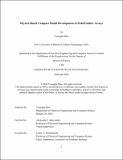| dc.contributor.advisor | Akinwande, Akintunde I. | |
| dc.contributor.author | Shin, Youngjin | |
| dc.date.accessioned | 2024-03-21T19:14:47Z | |
| dc.date.available | 2024-03-21T19:14:47Z | |
| dc.date.issued | 2024-02 | |
| dc.date.submitted | 2024-02-21T17:10:19.743Z | |
| dc.identifier.uri | https://hdl.handle.net/1721.1/153903 | |
| dc.description.abstract | Field Emitter Arrays (FEAs) - based cold cathodes have shown promise as electron sources in devices capable of high power and high frequency operation for a variety of applications such as microwave power amplifiers, pressure sensors, x-ray sources and high-power excimer lasers. Limited work has been done exploring the device characteristics using well defined cathode to anode separation. Consequently, FEAs lack a physics-based compact model. In this work, a flat stand-off anode was placed on the FEAs, which guarantees the anode-to-emitter distance and the parallel condition. The I-V characteristics in the space charge limit show an unexplained, yet reproducible Negative Differential Resistance (NDR) region resulting in a double saturation behavior. Upon further analysis of the electrostatics, the parallel-plate configuration was found to introduce a 2-dimensional acceleration channel affecting electron transport in the space between the anode and the gate electrode. Using simulation results of the electric field and potential distributions, the collection velocities of the emitted electrons were calculated, revealing that the current collection at the anode is electrostatically limited due to the deceleration of the electrons in the vacuum channel when the anode bias is below the gate bias. Although the physical mechanisms behind the NDR region are not fully understood, a qualitative conjecture with relation to the electrostatics is provided. The modeling approach approximates the current density distribution to a Gaussian distribution. The error function is used to calculate the integral of the Gaussian distribution, representing the normalized current density of the output characteristics. The error function is parametrized to predict the experimental I-V behavior in the separate operating regimes of the device. The resulting FEA model contains 22 fitting parameters, and the model function is only dependent on 4 physical parameters consisting of the anode and gate biases, anode separation distance, and the anode material work function. The resulting model shows more than reasonable accuracy within typical operation ranges of FEAs and captures the trends as observed in the experimental data. The compact model also includes the behavior of the NDR regime, opening new avenues of applications for FEAs including oscillators and frequency dividers. | |
| dc.publisher | Massachusetts Institute of Technology | |
| dc.rights | In Copyright - Educational Use Permitted | |
| dc.rights | Copyright retained by author(s) | |
| dc.rights.uri | https://rightsstatements.org/page/InC-EDU/1.0/ | |
| dc.title | Physics-Based Compact Model Development of Field Emitter Arrays | |
| dc.type | Thesis | |
| dc.description.degree | S.M. | |
| dc.contributor.department | Massachusetts Institute of Technology. Department of Electrical Engineering and Computer Science | |
| dc.identifier.orcid | https://orcid.org/0000-0003-2711-035X | |
| mit.thesis.degree | Master | |
| thesis.degree.name | Master of Science in Electrical Engineering and Computer Science | |
